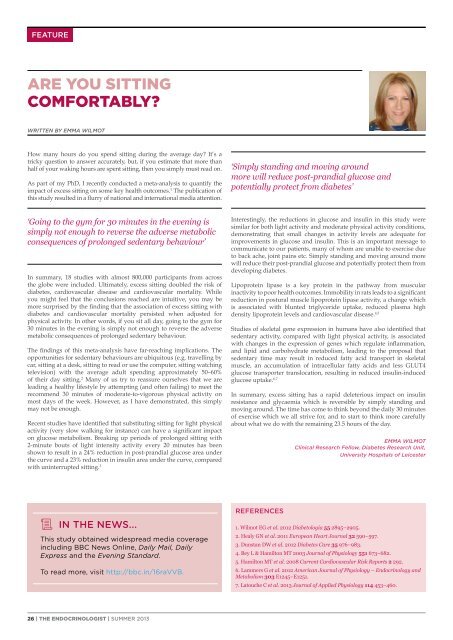Howard Jacobs
Howard Jacobs
Howard Jacobs
Create successful ePaper yourself
Turn your PDF publications into a flip-book with our unique Google optimized e-Paper software.
FEAtURE<br />
ARE YOU SITTING<br />
COMFORTABLY?<br />
WrITTEn BY EMMA WILMoT<br />
How many hours do you spend sitting during the average day? It’s a<br />
tricky question to answer accurately, but, if you estimate that more than<br />
half of your waking hours are spent sitting, then you simply must read on.<br />
As part of my PhD, I recently conducted a meta-analysis to quantify the<br />
impact of excess sitting on some key health outcomes. 1 The publication of<br />
this study resulted in a flurry of national and international media attention.<br />
‘Going to the gym for 30 minutes in the evening is<br />
simply not enough to reverse the adverse metabolic<br />
consequences of prolonged sedentary behaviour’<br />
In summary, 18 studies with almost 800,000 participants from across<br />
the globe were included. Ultimately, excess sitting doubled the risk of<br />
diabetes, cardiovascular disease and cardiovascular mortality. While<br />
you might feel that the conclusions reached are intuitive, you may be<br />
more surprised by the finding that the association of excess sitting with<br />
diabetes and cardiovascular mortality persisted when adjusted for<br />
physical activity. In other words, if you sit all day, going to the gym for<br />
30 minutes in the evening is simply not enough to reverse the adverse<br />
metabolic consequences of prolonged sedentary behaviour.<br />
The findings of this meta-analysis have far-reaching implications. The<br />
opportunities for sedentary behaviours are ubiquitous (e.g. travelling by<br />
car, sitting at a desk, sitting to read or use the computer, sitting watching<br />
television) with the average adult spending approximately 50–60%<br />
of their day sitting. 2 Many of us try to reassure ourselves that we are<br />
leading a healthy lifestyle by attempting (and often failing) to meet the<br />
recommend 30 minutes of moderate-to-vigorous physical activity on<br />
most days of the week. However, as I have demonstrated, this simply<br />
may not be enough.<br />
Recent studies have identified that substituting sitting for light physical<br />
activity (very slow walking for instance) can have a significant impact<br />
on glucose metabolism. Breaking up periods of prolonged sitting with<br />
2-minute bouts of light intensity activity every 20 minutes has been<br />
shown to result in a 24% reduction in post-prandial glucose area under<br />
the curve and a 23% reduction in insulin area under the curve, compared<br />
with uninterrupted sitting. 3<br />
IN THE NEWS...<br />
This study obtained widespread media coverage<br />
including BBC News Online, Daily Mail, Daily<br />
Express and the Evening Standard.<br />
To read more, visit http://bbc.in/16raVVB.<br />
26 | THE ENDOCRINOLOGIST | SUMMER 2013<br />
‘Simply standing and moving around<br />
more will reduce post-prandial glucose and<br />
potentially protect from diabetes’<br />
Interestingly, the reductions in glucose and insulin in this study were<br />
similar for both light activity and moderate physical activity conditions,<br />
demonstrating that small changes in activity levels are adequate for<br />
improvements in glucose and insulin. This is an important message to<br />
communicate to our patients, many of whom are unable to exercise due<br />
to back ache, joint pains etc. Simply standing and moving around more<br />
will reduce their post-prandial glucose and potentially protect them from<br />
developing diabetes.<br />
Lipoprotein lipase is a key protein in the pathway from muscular<br />
inactivity to poor health outcomes. Immobility in rats leads to a significant<br />
reduction in postural muscle lipoprotein lipase activity, a change which<br />
is associated with blunted triglyceride uptake, reduced plasma high<br />
density lipoprotein levels and cardiovascular disease. 4,5<br />
Studies of skeletal gene expression in humans have also identified that<br />
sedentary activity, compared with light physical activity, is associated<br />
with changes in the expression of genes which regulate inflammation,<br />
and lipid and carbohydrate metabolism, leading to the proposal that<br />
sedentary time may result in reduced fatty acid transport in skeletal<br />
muscle, an accumulation of intracellular fatty acids and less GLUT4<br />
glucose transporter translocation, resulting in reduced insulin-induced<br />
glucose uptake. 6,7<br />
In summary, excess sitting has a rapid deleterious impact on insulin<br />
resistance and glycaemia which is reversible by simply standing and<br />
moving around. The time has come to think beyond the daily 30 minutes<br />
of exercise which we all strive for, and to start to think more carefully<br />
about what we do with the remaining 23.5 hours of the day.<br />
REFERENCES<br />
EMMA WILMoT<br />
Clinical research Fellow, diabetes research unit,<br />
university hospitals of Leicester<br />
1. Wilmot EG et al. 2012 Diabetologia 55 2895–2905.<br />
2. Healy GN et al. 2011 European Heart Journal 32 590–597.<br />
3. Dunstan DW et al. 2012 Diabetes Care 35 976–983.<br />
4. Bey L & Hamilton MT 2003 Journal of Physiology 551 673–682.<br />
5. Hamilton MT et al. 2008 Current Cardiovascular Risk Reports 2 292.<br />
6. Lammers G et al. 2012 American Journal of Physiology – Endocrinology and<br />
Metabolism 303 E1245–E1251.<br />
7. Latouche C et al. 2013 Journal of Applied Physiology 114 453–460.


